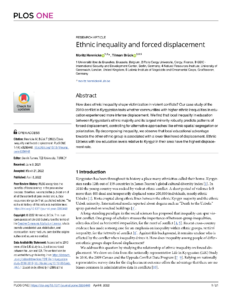How does ethnic inequality shape victimization in violent conflicts? Our case study of the 2010 conflict in Kyrgyzstan tests whether communities with higher ethnic inequalities in education experienced more intense displacement. We find that local inequality in education between Kyrgyzstan’s ethnic majority and its largest minority robustly predicts patterns of forced displacement, controlling for alternative approaches like ethnic spatial segregation or polarization. By decomposing inequality, we observe that local educational advantage towards the other ethnic group is associated with a lower likelihood of displacement. Ethnic Uzbeks with low education levels relative to Kyrgyz in their area have the highest displacement rate.
Publication Details
- Year of Publication: 2022
- Region/s: Central Asia
- Theme/s: Life in Kyrgyzstan · Micro-Data Collection · Violence & Peacebuilding
- Research Topic/s: Education · Peacebuilding & Reconstruction · Poverty & Inequality · Social Cohesion · Violence & Conflict
- Method/s: Panel Data Analysis
- DOI: https://doi.org/10.1371/journal.pone.0266448




